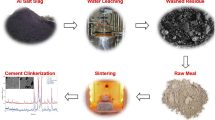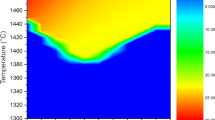Abstract
The possibility of adding an aluminium black dross leached residue (BDLR), mainly consisted of spinel (Al2MgO4) and corundum (Al2O3), in the raw meal for the production of Portland cement clinker was investigated. This leached residue was obtained during the hydrothermal treatment of an aluminium black dross, formed during aluminium scrap melting. The process consisted of crushing and grinding of the as received dross, sieving it to recover the Al metal value, water leaching at high temperature to dissolve the salts and, finally, aluminium recovery by alkaline pressure leaching. Three samples of raw meals were prepared, one with ordinary raw materials, as a reference sample ((PC)Ref), and two others with different content (2 and 4 wt%) of BDLR ((PC)BD-2% and (PC)BD-42%). All raw meals were sintered at 1,450 ◦C and the produced clinkers were characterised by chemical analysis, X-ray diffraction (XRD), thermogravimetric/differential thermal analysis (TG/DTA) as well as scanning electron microscopy. The produced cements were tested by determining their grindability, setting time, compressive strength and expansibility. The hydration products were examined by XRD analysis at 2, 7 and 28 days. The results of the physico-mechanical tests showed that BDLR could be utilized as a raw material in the cement clinker production, presenting a promising alternative to disposal in landfills.










Similar content being viewed by others
References
Hwang, J.Y., Huang, X., Xu, Z.: Recovery of metals from aluminium dross and salt cake. J. Min. Mat. Charact. Eng. 5, 47–62 (2006)
Jody, B.J., Daniels, E.J., Bonsignore, P.V., Karvelas, D.E.: Recycling of aluminum salt cake. J. Resour. Manage. Technol. 20, 38–49 (1992)
Tsakiridis, P.E.: Aluminium salt slag characterization and utilization: a review. J. Hazard. Mater. 217–218, 1–10 (2012)
European Waste Catalogue and Hazardous Waste List, Environmental Protection Agency, Ireland, Valid from 1 January 2002
K.E. Lorber, H. Antrekowitsch, Treatment and disposal of residues from aluminium dross recovery, in: 2nd International Conference on Hazardous and Industrial Waste Management, Crete, 2010, p. B.2.1
Tsakiridis, P.E., Oustadakis, P., Agatzini-Leonardou, S.: Aluminium recovery during black dross hydrothermal treatment. J. Environ. Chem. Eng. 1, 23–32 (2013)
Al-Dhamri, H., Melghit, K.: Use of alumina spent catalyst and RFCC wastes from petroleum refinery to substitute bauxite in the preparation of Portland clinker. J. Hazard. Mater. 179, 852–859 (2010)
Alp, İ., Deveci, H., Süngün, H.: Utilization of flotation wastes of copper slag as raw material in cement production. J. Hazard. Mater. 159, 390–395 (2008)
Pontikes, Y., Angelopoulos, G.N.: Bauxite residue in cement and cementitious applications: current status and a possible way forward. Resour. Conserv. Recy. 73, 53–63 (2013)
Ewais, E.M.M., Khalil, N.M., Amin, M.S., Ahmed, Y.M.Z., Barakat, M.A.: Utilization of aluminum sludge and aluminum slag (dross) for the manufacture of calcium aluminate cement. Ceram. Int. 35, 3381–3388 (2009)
Pereira, D.A., Aguiar, B., Castro, F., Almeida, M.F., Labrincha, J.A.: Mechanical behaviour of Portland cement mortars with incorporation of Al-containing salt slags. Cem. Concr. Res. 30, 1131–1138 (2000)
Shinzato, M.C., Hypolito, R.: Solid waste from aluminum recycling process: characterization and reuse of its economically valuable constituents. Waste Manage. 25, 37–46 (2005)
American Society for Testing and Materials–ASTM. ASTM C204: Standard test method for fineness of hydraulic cement by air permeability apparatus. ASTM International; 2000. Document Number: ASTM C204-00
British Standards Institution. ΕΝ 196-1: Methods of testing cement: part 1: Determination of compressive strength. 2005
British Standards Institution. ΕΝ 196-3: Methods of testing cementl: part 3: Determination of setting time and soundness. 2005
Tokyay, M.: Effect of chemical composition of clinker on grinding energy requirement. Cem. Concr. Res. 29, 531–535 (1999)
Frigione, G., Zenone, F., Esposito, M.V.: The effect of chemical composition on Portland cement clinker grindability. Cem. Concr. Res. 13, 483–492 (1983)
Duda, W.H.: Cement data book, 2nd edn. Bauverlag GmbH, Wiesbaden (1977)
Gouda, G.R.: Effect of clinker composition on grindability. Cem. Concr. Res. 9, 209–218 (1979)
American Society for Testing and Materials–ASTM. ASTM C1437: Standard test method for flow of hydraulic cement mortar. ASTM International. 1999. Document Number: ASTM C1437-01
Author information
Authors and Affiliations
Corresponding author
Rights and permissions
About this article
Cite this article
Tsakiridis, P.E., Oustadakis, P. & Agatzini-Leonardou, S. Black Dross Leached Residue: An Alternative Raw Material for Portland Cement Clinker. Waste Biomass Valor 5, 973–983 (2014). https://doi.org/10.1007/s12649-014-9313-8
Received:
Accepted:
Published:
Issue Date:
DOI: https://doi.org/10.1007/s12649-014-9313-8




